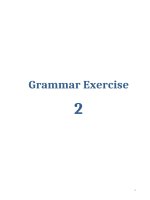Exercise process diagram 1
Bạn đang xem bản rút gọn của tài liệu. Xem và tải ngay bản đầy đủ của tài liệu tại đây (330.49 KB, 3 trang )
Process Diagram
The diagram illustrates the process that is used to manufacture bricks for the building
industry.
Summarize the information by selecting and reporting the main features and make
comparisons where relevant.
Answer
The flow chart shows how bricks are produced for, and delivered to the building industry.
Overall, there are 7 stages in the whole brick producing process, beginning with clay
excavation and ending with the delivery of the bricks to the customers.
Firstly, clay is dug up by using a big digger. To get rid of the oversized pieces, clay is placed
on a metal grid and small pieces drop onto a large roller. At the next stage, sand and water are
added to the clay. After the bricks are shaped by using a wire cutter or a mould, they are moved
to a drying oven for 24 to 48 hours.
Those bricks are then fired in a special kiln at a moderate temperature (200c - 980c) at the
fourth step. Afterwards, they continue to be heated for the second time at a higher temperature
(870c - 1300c) in another kiln. Before being packaged at the sixth stage, the bricks are treated
in a cooling chamber for 48 to 72 hours. The entire brick producing process concludes after
the bricks are delivered to customers.
183 words
Vocabulary:
Clay (đất sét): clay is a type of earth which is very heavy, unlike sand which is relatively light
Brick (gạch): a brick is a rectangular object made by heating clay until it becomes solid. It is
used in many countries to construct houses or other buildings.
Digger (máy đào): the machine shown in the diagram is often referred to [at least in the UK] as a
JCB. Its function is to „dig‟ or to make a hole in the ground.
Excavation (sự đào): although there are two similar verbs – „dig‟ and „excavate‟, the noun
„excavation‟ is commonly used in the construction industry. It suggests something on a large scale
where we make a big hole in the ground, as in the excavation of clay for example.
Dug up (đào đất để lấy lên): note the irregular past simple tense/and past participle of the verb
„dig‟. Here the phrasal verb „dig up‟ is used to mean an activity when we make a hole in the
ground with a machine.
Cutter (máy cắt): in the same way as a „digger‟ is something which digs, a „cutter‟ is
something which cuts. In this case, the cutter is made or „wire‟ or thin metal as shown in the
diagram.
Mould (khuôn): a mould is an object which is used to form a shape. In this case, the sand and
water mixture is placed in a mould to make the shape of a brick.
Fire (lửa): the verb „fire‟ has several meanings. Here, it refers to the action of heating an object
made from clay.
Kiln(lò sấy): a kiln is similar to an oven, but it has a different function. An oven is used for
cooking or heating food – usually in the home. A kiln – like the one in the diagram – is usually used
in industrial processes for making some material very hard. It can be used in different processes at
really high temperatures for heating things, to make iron for example.
Chamber (buồng): the process in the diagram shows that the bricks are very hot when they go
into this closed space or chamber. They undergo „cooling‟ – they become less and less hot.









